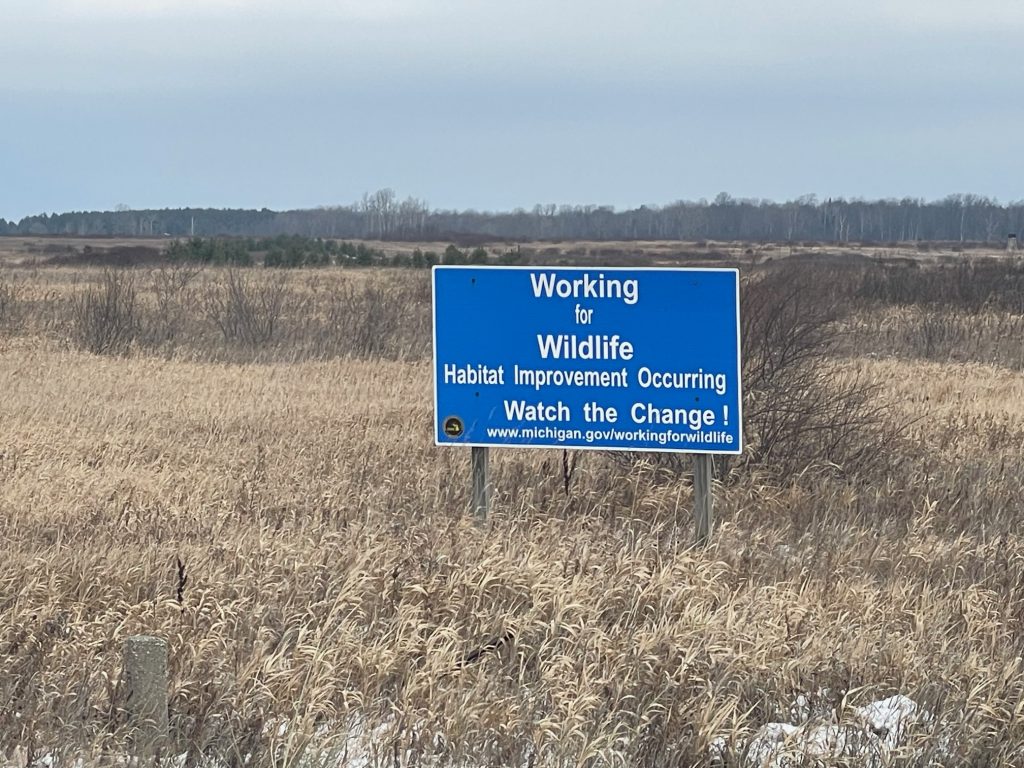

If you’ve taken a drive north of Marion on M-66 lately, you’ve probably noticed some trucks and heavy equipment out on the state game area between 23 Mile and County Line Road.
“We have two parts of the same project that we’re working on,” said Michigan DNR Wildlife Biologist Vernon Richardson.
“What the equipment out there is doing right now, is some wetland restoration and improvement work.”
Boiled down to the basics, the Michigan DNR – in conjunction with the Federal Fish and Wildlife Services – is working to restore that state game area back to a more natural wildlife habitat. Before that piece of land was purchased by the state, farmers had made changes to the land to use it for agriculture. With this project, those changes will be reversed.
“Back in the day, that area, along with a lot of other areas in this part of the state here, was ditched and drained at some point for agricultural production purposes,” Richardson said.
“That would have been beneficial for farmers for pasture, or hay, or grow crops… but that comes at the cost of the wetland habitat, and the wildlife species that use those.”
While the wetland habitat will be restored, Richardson wanted to make clear that changes that are being made aren’t meant to flood the area.
“Across the middle of that parcel is a county drain, and that serves the area,” Richardson said. “We’re not messing with that; that would backwater up to neighboring parcels, and we don’t want that to happen.”
The current heavy equipment work involves breaking up the man-made drainage systems and moving dirt.
“In a couple of cases out there, where we know there is drain tile, we’re going to go in and remove it or break it; plug it, so that it’s no longer draining what was a wetland pocket – and is only not a wetland pocket because there’s a pipe draining it.” said Richardson.
“What you see, most of the surface work that you see out there, is they’re blocking off the areas that were ditched; moving soil around to an area that was ditched and blocking it, or an area that is adjacent to a ditch, a low area, where if we put a little soil there, we can restore the area to the natural water flow system that would’ve been present had it not been altered.”
And while wetland restoration is a big part of the current project, Richardson wants locals to know that there will still be plenty of high ground areas. The areas that are being targeted for restoration are considered small pockets of lowland, wet areas. The largest area of wetland that will be restored will be approximately 40 acres, close to the center of the 700 + acre state game area.
“It’s still going to be a mixture of grassland and wetland. There’s plenty of high ground area that’s not going to be under water. [The property] looks like it’s flat, but it’s not. Most of the areas that we’re working on will be less than 2 feet deep, and a couple of acres.”
As for the 40-acre wetland location in the center of the state game area, Richardson said that that part of the property is already wet, but will now be a deeper and larger wetland area.
“That will be a great spot for Mallard Ducks,” Richardson said. “And that’s a large enough body of water for them to raise their brood all summer. The young can’t fly, and they must have a large enough body of water that they can walk to, and then they’ll fly in the fall.”
The second part of the project that the DNR and Fish and Wildlife Services are working on, involves increasing the quality of the adjacent grasslands on the property.
“We’re going to replant some grasslands out there,” Richardson said. “That type of grassland work, we’ve been doing some version of that ever since we’ve owned the property, I believe since the ‘80s.”
As for a timeline on the project, Richardson anticipates that the heavy equipment work will wrap up soon, with planting and finish work to be done in the spring.
“We should be done with the heavy equipment work out there in the next couple of weeks,” Richardson said. “We’ll be doing the planting work out there in the spring. The bulk of the work on the project should be done by early summer. The wetland areas, those will look great by spring; the grassland areas, those will take a little longer.”
The biggest benefit for locals, according to Richardson, will be the increase in the amount of wildlife on the property.
“There should be more waterfowl in the area, with a 40 acre pond out towards the middle, year-round,” Richardson said. “There should be more numbers of ducks, along with more species of ducks in the area. More birds in the area; whether you intentionally go out there to look at them, or just seeing them by driving around.”
Along with the numbers of birds, having native grasslands adjacent to wetlands should also give people the opportunity to see rare birds and other animals.
“There’s certainly value for other wildlife species, but most of those aren’t casually observed,” Richardson said. “Snakes, turtles, frogs, insects… some grassland bird species that people who engage in bird watching will recognize that are rare in Michigan.”
